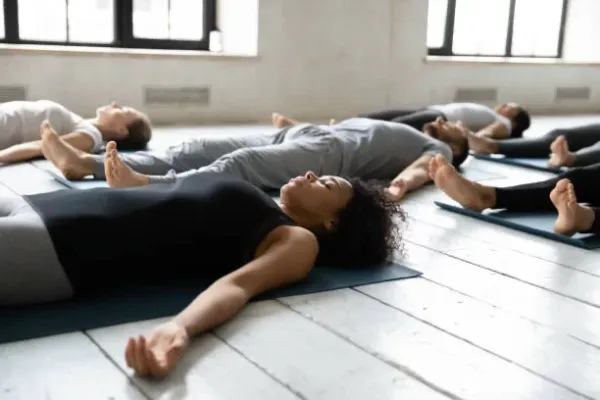Effective relaxation techniques can help alleviate stress, promote a sense of calm, and improve overall well-being. Here are several techniques you can try:
- Deep Breathing: Practice deep breathing exercises to activate the body’s relaxation response. Try inhaling deeply through your nose, allowing your abdomen to expand, and then exhaling slowly through your mouth. Repeat this several times, focusing on the rhythm of your breath.
- Progressive Muscle Relaxation (PMR): PMR involves tensing and then relaxing each muscle group in the body, one at a time. Start with your toes and work your way up to your head, tensing each muscle group for a few seconds before releasing the tension.
- Guided Imagery: Use guided imagery or visualization techniques to imagine yourself in a peaceful and serene environment. Close your eyes and visualize a place where you feel safe and relaxed, such as a beach or a tranquil forest. Focus on engaging all your senses in the visualization.
- Mindfulness Meditation: Practice mindfulness meditation by focusing your attention on the present moment without judgment. You can focus on your breath, sensations in your body, or sounds in your environment. Whenever your mind wanders, gently bring your focus back to the present moment.
- Yoga: Engage in gentle yoga poses and stretches to release tension and promote relaxation. Yoga combines physical movement with breath awareness, making it an effective practice for reducing stress and calming the mind.
- Progressive Relaxation Techniques: Use progressive relaxation techniques to systematically relax different parts of your body. Start by tensing and then releasing tension in each muscle group, working your way from your feet to your head.
- Autogenic Training: Autogenic training involves repeating a series of self-statements to induce a state of deep relaxation. Statements typically focus on sensations of warmth and heaviness in the body, helping to calm the nervous system.
- Aromatherapy: Use essential oils such as lavender, chamomile, or bergamot to create a relaxing atmosphere. You can diffuse the oils in your living space, add them to a warm bath, or apply them topically to pulse points.
- Progressive Relaxation Music: Listen to calming music or nature sounds to help relax your mind and body. Choose music with a slow tempo and minimal instrumentation to create a soothing ambiance.
- Massage or Self-Massage: Give yourself a gentle massage or use self-massage techniques to release tension in your muscles. Focus on areas of your body that commonly hold stress, such as your neck, shoulders, and back.
Experiment with different relaxation techniques to find what works best for you, and incorporate them into your daily routine to promote relaxation and stress relief.
How to Record Your Meditations on YouTube
Recording your meditations for YouTube can be a wonderful way to share your practice with others and contribute to the online meditation community. Here’s a step-by-step guide to help you get started:
- Plan Your Content:
- Decide on the type of meditation you want to share, such as guided mindfulness meditation, body scan meditation, loving-kindness meditation, or visualization meditation.
- Determine the length of your meditation session. It can vary depending on your preference and the focus of your meditation, but anywhere from 5 to 30 minutes is common for YouTube videos.
- Create a Script or Outline:
- Write a script or outline for your meditation session. This will help you stay focused and provide clear guidance for your viewers.
- Include instructions on how to prepare for the meditation, what to focus on during the practice, and how to transition out of the meditation at the end.
- Set Up Your Recording Space:
- Choose a quiet and comfortable space to record your meditation sessions. Make sure there are minimal distractions and background noise.
- Consider using a backdrop or setting up your recording space in a visually appealing environment that reflects the theme of your meditation.
- Gather Your Equipment:
- Use a high-quality camera to record your video. This could be a DSLR camera, a smartphone with a good camera, or a webcam.
- Invest in a microphone to ensure clear audio quality. A lavalier microphone or a USB microphone can work well for recording voiceovers.
- Record Your Meditation Session:
- Set up your camera and microphone in the desired position.
- Start recording and follow your script or outline as you guide the meditation session.
- Speak clearly and at a relaxed pace, allowing for pauses and moments of silence as needed.
- Edit Your Video:
- Use video editing software to trim any unnecessary footage and refine your recording.
- Add any visual elements or text overlays to enhance the viewer experience.
- Pay attention to audio quality and adjust levels as needed to ensure clear sound.
- Upload Your Video to YouTube:
- Create a YouTube account if you don’t already have one.
- Click on the “Upload” button and select your edited video file.
- Add a descriptive title, relevant tags, and a thorough description to help viewers find your meditation video.
- Choose a visually appealing thumbnail image to represent your video.
- Set your video to public or unlisted, depending on your preference for who can view it.
- Share Your Video:
- Share your meditation video on social media platforms, meditation forums, and with friends and family to help it reach a wider audience.
- Encourage viewers to subscribe to your channel and leave feedback or questions in the comments section.
By following these steps, you can create and share your meditation recordings on YouTube, contributing to the growing library of online meditation resources and reaching people around the world who can benefit from your guidance.
